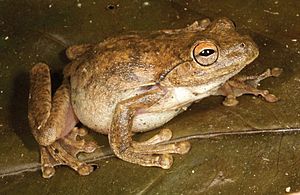Everett's Timor tree frog facts for kids
Quick facts for kids Everett's Timor tree frog |
|
|---|---|
 |
|
| Conservation status | |
| Scientific classification | |
| Synonyms | |
|
The Everett's Timor tree frog (Litoria everetii) is a cool type of tree frog that lives in Indonesia. These frogs have been spotted on the Sunda Islands, sometimes as high as 1500 meters (about 4,900 feet) above sea level. Imagine living that high up!
Contents
What is a Tree Frog?
Tree frogs are amazing amphibians known for their special toes. They have sticky pads on their toes that help them climb trees and other smooth surfaces. This means they can live high up in the forest canopy, not just on the ground.
Where Do They Live?
Everett's Timor tree frogs are found in Indonesia. Specifically, they live on the Sunda Islands. These islands are part of a large group of islands in Southeast Asia. They prefer places that are moist and green, like forests.
Their Home in the Islands
These frogs like to live in different kinds of habitats. They can be found near streams or other water sources. Living high up in the mountains means they are used to cooler temperatures than frogs living closer to the coast.
What Do They Look Like?
Like many tree frogs, the Everett's Timor tree frog is probably small and well-camouflaged. Their skin color helps them blend in with leaves and branches. This makes it hard for predators to spot them.
Special Features
- Sticky Toes: Their toe pads are super helpful for climbing. They can stick to almost anything!
- Big Eyes: Frogs usually have large eyes that help them see well, especially at night when they are most active.
What Do They Eat?
Most tree frogs are carnivores, meaning they eat other animals. They are skilled hunters.
- Insect Eaters: Their main diet includes insects like flies, mosquitoes, and beetles.
- Night Hunters: They often hunt for food when it's dark.
Life Cycle and Reproduction
Like all frogs, Everett's Timor tree frogs start their lives in water.
- Eggs: Female frogs lay their eggs, usually in or near water.
- Tadpoles: The eggs hatch into tadpoles, which are like tiny fish. Tadpoles live in water and breathe with gills.
- Froglets: As they grow, tadpoles slowly change. They develop legs, lose their tails, and start to look more like tiny frogs.
- Adults: Finally, they become adult frogs and can live on land, though they still need moisture.
Why Are They Important?
Every animal plays a part in its ecosystem. Frogs help control insect populations. They are also food for other animals, like snakes and birds.
Conservation Status
The Everett's Timor tree frog is listed as Data Deficient (DD) by the International Union for Conservation of Nature (IUCN).
- What "Data Deficient" Means: This means scientists don't have enough information about how many of these frogs exist or if their numbers are going down.
- Why It Matters: Without enough data, it's hard to know if they need special protection. More research is needed to understand their population and habitat.


